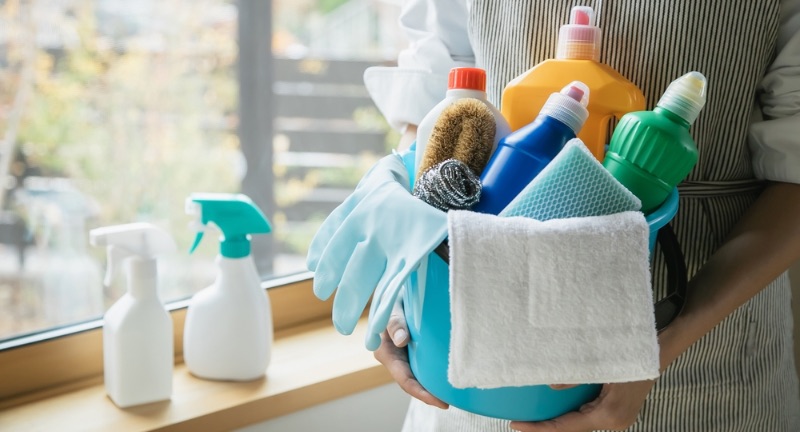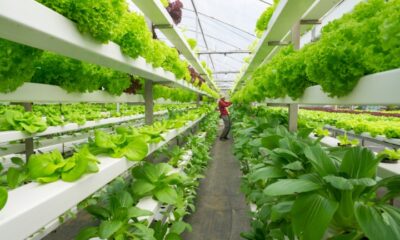ECONOMY
Why You Should Throw Out Your Cleaning Products
Published
2 months agoon

Shutterstock
Cleaning is a battlefield between you and the unseen grime plotting world domination from every corner of your home. While scrubbing away, ever wonder if your cleaning products are really on your side? Spoiler alert: not all of them are! From chemicals with names you can’t pronounce to fragrances that could knock out a bear, it may be time to throw out your cleaning products. Let’s look into why being picky about your cleaning products isn’t just trendy, it’s necessary (and a lot smarter than trusting that shady bottle under your sink).
Allergens in Products

Shutterstock
Cleaning products often contain allergens that can trigger sneezing, rashes, or more severe reactions. These hidden irritants can linger on surfaces or in the air, affecting sensitive individuals. Being cautious about what’s in your products helps create a safer environment for everyone. Choosing hypoallergenic alternatives reduces the risk of exposure to potentially harmful substances.
Toxic Chemicals

Shutterstock
Many cleaning products are filled with harsh chemicals that can pose serious health risks. Prolonged exposure to these toxins may lead to respiratory issues or other long-term health problems. Ensuring your cleaning products are free from toxic ingredients is essential for maintaining a healthy home. Opt for products with natural or safer chemical compositions to protect yourself and your loved ones.
Residue on Surfaces

Shutterstock
Cleaning products that leave residues can attract more dirt and grime over time. These residues can also be harmful, especially if ingested or touched by children or pets. Selecting products that rinse cleanly ensures your home stays genuinely clean. Prioritizing residue-free options helps maintain a polished and safe living space.
Indoor Air Quality

Shutterstock
The air inside your home can be more polluted than the air outside, and cleaning products often contribute to this problem. Volatile organic compounds (VOCs) released by certain cleaners can harm respiratory health. Choosing low-VOC or VOC-free products helps improve air quality. Fresh, clean air makes your home a healthier place to live and breathe.
Skin Irritation

Shutterstock
Direct contact with certain cleaning products can lead to redness, itching, or even chemical burns on your skin. Many products contain harsh ingredients that strip away natural oils, leaving your skin vulnerable. By choosing skin-friendly or dermatologist-tested products, you protect yourself from unnecessary irritation. Look for options labeled as gentle or suitable for sensitive skin to clean effectively without discomfort.
Long-Term Health Risks

Shutterstock
Continuous exposure to hazardous cleaning chemicals can have cumulative health effects over time. Issues like hormonal disruption, respiratory diseases, and even certain cancers have been linked to toxic cleaning agents. Choosing safer products helps reduce these long-term risks. A little vigilance today ensures a healthier tomorrow for you and your family.
Impact on Pets

Shutterstock
Many common cleaning products can be highly toxic to pets, affecting their skin, digestion, or respiratory system. Dogs, cats, and other animals may accidentally ingest harmful residues or inhale fumes. Pet-safe cleaning options ensure your furry friends are protected. Always check labels for pet-friendly assurances to keep them healthy and happy.
Children’s Safety

Shutterstock
Children are especially vulnerable to the harmful effects of harsh cleaning chemicals. Their developing bodies and curious habits make exposure a significant concern. Opting for non-toxic, child-safe products reduces risks while keeping your home clean. Ensuring safety for little ones should always be a top priority in your cleaning choices.
Environmental Harm

Shutterstock
The ingredients in cleaning products often end up in waterways, affecting ecosystems and wildlife. Phosphates, bleach, and other harsh chemicals can disrupt aquatic life and pollute drinking water. Using eco-friendly cleaners minimizes your environmental footprint. Supporting green initiatives through your purchases helps protect the planet for future generations.
Water Contamination

Shutterstock
When cleaning products wash down the drain, they can contribute to water pollution. Non-biodegradable ingredients accumulate, causing harm to aquatic ecosystems. Choosing biodegradable and non-toxic options prevents unnecessary contamination. Every small change makes a significant impact on keeping water sources clean and safe.
Biodegradability

Shutterstock
Biodegradable cleaning products break down naturally without leaving harmful residues in the environment. This reduces waste and helps maintain the balance of ecosystems. Prioritizing these products supports sustainable practices and limits your environmental impact. Switching to biodegradable cleaners is a small step with a big payoff for the planet.
Effectiveness on Specific Surfaces

Shutterstock
Not all cleaning products are suitable for every surface in your home. Using the wrong cleaner can damage delicate materials like marble, wood, or stainless steel. Choosing products designed for specific surfaces ensures effective cleaning without causing harm. Understanding your cleaning needs helps maintain the integrity and longevity of your belongings.
Reaction with Other Products

Shutterstock
Some cleaning products can produce dangerous reactions when mixed, such as chlorine gas from bleach and ammonia. These reactions can pose immediate health risks and even lead to hospital visits. Being mindful of product ingredients and avoiding harmful combinations is crucial. Always read labels and follow usage instructions to ensure safety in your cleaning routine.
Storage Safety

Shutterstock
Improper storage of cleaning products can lead to leaks, spills, or accidental poisoning. Certain chemicals require cool, dry conditions to remain stable and safe. Choosing products with clear storage guidelines and safety locks helps prevent accidents. Always ensure cleaning supplies are stored securely and out of reach of children and pets.
Flammability Concerns

Shutterstock
Some cleaning agents are highly flammable, posing risks when used near heat sources. Products containing alcohol or petroleum-based solvents should be handled with extra caution. Choosing non-flammable alternatives reduces the chances of fire hazards in your home. Always check product labels for flammability warnings and take necessary precautions.
VOC (Volatile Organic Compound) Emissions

Shutterstock
Volatile Organic Compounds (VOCs) released by many cleaning products can degrade air quality and harm health. These emissions are linked to headaches, dizziness, and long-term respiratory issues. Opting for VOC-free products helps create a cleaner, healthier living environment. Make informed choices to reduce exposure to these harmful chemicals.
Cost-Effectiveness

Shutterstock
Not all cleaning products deliver equal value for their price. Some cheaper options may require more product or effort to achieve the same results. Investing in effective, concentrated cleaners often saves money in the long run. Choose wisely to balance cost and performance without sacrificing safety or quality.
Ethical Sourcing

Shutterstock
The sourcing of ingredients for cleaning products impacts global communities and ecosystems. Supporting brands committed to ethical practices promotes fair labor and sustainable harvesting. Look for certifications like Fair Trade or B-Corp when selecting your cleaners. Your choices can contribute to a better world for all.
Manufacturing Practices

Shutterstock
How a product is made matters as much as its ingredients. Many cleaning products are manufactured using processes that emit pollutants or waste energy. Choosing brands committed to eco-friendly manufacturing reduces your environmental impact. Supporting responsible practices encourages more companies to follow suit.
Packaging Waste

Shutterstock
Single-use plastics and non-recyclable packaging from cleaning products contribute significantly to global waste. Opting for products with refillable containers or recyclable materials helps reduce this burden. Many brands now offer innovative solutions to minimize packaging waste without compromising quality. Choosing eco-friendly packaging is a simple yet impactful step toward sustainability.
Antimicrobial Resistance Risks

Shutterstock
Overusing antimicrobial cleaners can contribute to the growing issue of antimicrobial resistance. This makes bacteria harder to eliminate and poses a significant health threat globally. Opting for regular, non-antibacterial products for routine cleaning can help mitigate this risk. Save antimicrobial cleaners for situations requiring disinfection to balance hygiene with safety.
Non-Recyclable Packaging

Shutterstock
Non-recyclable packaging adds unnecessary waste to landfills, harming the environment. Choosing products with sustainable or easily recyclable materials helps combat this issue. Many brands are transitioning to eco-friendly options, making it easier for consumers to make greener choices. Supporting these efforts encourages widespread adoption of sustainable practices.
Fragrance Sensitivity

Shutterstock
Strong artificial fragrances in cleaning products can trigger headaches, allergies, or respiratory irritation. Fragrance-free or naturally scented products are better alternatives for those with sensitivities. A clean home doesn’t need to come at the expense of personal comfort. Prioritize products that provide effective cleaning without overpowering scents.
Regulatory Compliance

Shutterstock
Not all cleaning products meet the same regulatory standards, especially when purchased from different regions. Ensuring your products comply with safety and environmental regulations helps protect your health and the planet. Look for certifications or trusted labels to confirm compliance. An informed purchase helps you avoid subpar or unsafe options.
Product Transparency

Shutterstock
Transparent labeling on cleaning products allows you to make informed decisions about their safety and efficacy. Many manufacturers hide harmful chemicals behind vague terms like “fragrance” or “proprietary blend.” Choosing brands that prioritize transparency ensures you know exactly what you’re bringing into your home. Knowledge is power when it comes to maintaining a safe and clean environment.
Conclusion

Shutterstock
It is time to focus on staying one step ahead of toxic surprises and environmental regrets. By making smart swaps, you’re not only protecting your home but also becoming the person your future self will thank you for. Remember, the best cleaning product is the one that scrubs grime, not your conscience! Say goodbye to chemical chaos and hello to a healthier, happier home. After all, life’s too short to be outsmarted by your mop water.
Related Topics:

More From Lifestylogy
-


24 Uses For Bananas That Are Oddly Practical
-


What Is Hydroponics, And Why Is It So Important?
-


The Long History Of Cheese
-


20 Things People Mindlessly Spend Their Money On That Might…
-


26 Dirtiest Jobs In The World, Would You Brave One…
-


22 State Laws That Are Hard To Believe They Actually…
-


Hardwood Is The Best: Here’s Why
-


27 Habits To Implement That Could Change Your Life For…
-


To Buy or Not to Buy? The Realities of Homeownership